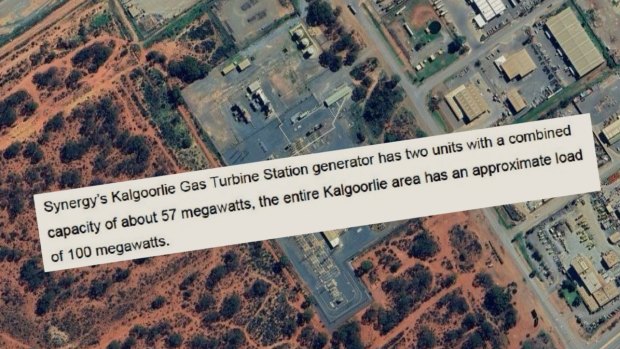- Exclusive
- National
- WA
- Electricity
This was published 10 months ago
Kalgoorlie’s power backups don’t have the juice for the whole town, FOI documents reveal
Kalgoorlie’s backup generators can only provide a little over half the power the town actually needs, leaving residents vulnerable to lengthy blackouts when cut off from the state’s largest power grid.
Internal communications from Synergy obtained by WAtoday under freedom of information laws reveal that the combined 57-megawatt capacity of Kalgoorlie’s backup power station is 37 megawatts short of the city’s normal energy demand.

The Synergy document reveals the huge shortfall in power from the West Kalgoorlie power station.Credit: Google Maps/Synergy
The documents covered the week after the huge electrical storm on January 17 that cut off, or “islanded”, Kalgoorlie from the state’s South West power grid for nearly a week and left the town dealing with 30 hours worth of blackouts.
A Synergy briefing note prepared on January 19 highlighted the precarious situation the Goldfields town faces when its only transmission line is impacted.
“At a combined capacity of about 57MW, the generators do not have sufficient capacity to power the entire Kalgoorlie area, which has an approximate load of 100MW,” the note said.
This shortfall from the 40-year-old station resulted in Synergy staff being directed to tell customers on January 22 to “limit energy use where possible”.
The documents have reignited opposition criticism of the state government’s lack of preparedness for events like this despite it knowing the two diesel backup generators didn’t have enough power for the whole town.
Opposition energy spokesman Steve Thomas said the government had not learned anything from the February 2022 heatwave-related outages that affected Kalgoorlie over 10 days.
“It was obviously an issue in 2022 when the lights went out for a period of time, and it remains an issue,” he said.
“In the last two years, demand has only increased, and the problem is going to be that it’s at least another two years under the current proposal before the thing gets fixed.
“So there are two more years of power outages to come, until you get a significant upgrade in that system.”
A spokesman for Energy Minister Reece Whitby acknowledged the January outage was frustrating for Kalgoorlie residents, but said the state had been working to boost backup generation capacity.
He said Western Power had recently closed a tender for 150 megawatts of additional generation capacity at the West Kalgoorlie plant which would be available by 2026.
“In the meantime, Synergy has worked with the Kalgoorlie Boulder Chamber of Commerce and Industry to select a contractor that can support the Kalgoorlie Gas Turbine Station’s operations,” he said.
The spokesman said the government’s energy transition agency PoweringWA was also investigating the development of a privately-owned regional Goldfields power grid that would create more electricity generation options by connecting the town to lower emission energy sources.
Organised chaos
The January blackout occurred on the evening of January 17 after a huge electrical storm cut the 220-kilovolt transmission line, the only line connecting Kalgoorlie to the South West power grid.
Blackouts lasted for about 30 hours for some residents while temperatures cracked 40 degrees.
Residents fumed as they were forced to shut businesses, throw out food and could not access fuel.
It was only thanks to power being fed into Kalgoorlie from the privately owned 110-megawatt Parkeston power station that powers nearby mining operations that the city had enough energy to run on while that transmission line was being fixed.
The FOI documents reveal in detail the mad scramble by Synergy, Western Power and Australian Energy Market Operator staff after the two gas turbines, known as KAL2 and KAL3 tripped shortly after being switched on.
The job was made much harder from the get-go after a suspected lightning strike interrupted AEMO’s remote operation controls of the West Kalgoorlie backup plant, forcing them to send a Western Power tech to start the generators.
After initial success, both turbines failed shortly after being switched on forcing the Western Power tech to problem-solve the issue while on the phone to Synergy.
Synergy also had to send out a technical crew on the first available flight the next morning and the generators were operating the next day, but it wasn’t until the Parkeston station started feeding into the grid that the city had the electricity it needed.
Curtin University energy systems expert Associate Professor Liam Wagner said the timeline showed that all parties involved in the grid did everything they could at the time.
However, Wagner said it revealed that communication infrastructure needed to be hardened.
“Its unfortunate but there needs to be some back up. There are satellite phones and internet connections that can prevent these sorts of things not working,” he said.
The spokesman for Whitby said Synergy and Western Power had invested heavily in communications upgrades since the January blackout.
“This includes significant upgrades to the Kalgoorlie Gas Turbine Station’s control system, as well as the installation of a Starlink satellite communication system,” he said.
Start the day with a summary of the day’s most important and interesting stories, analysis and insights. Sign up for our Morning Edition newsletter.